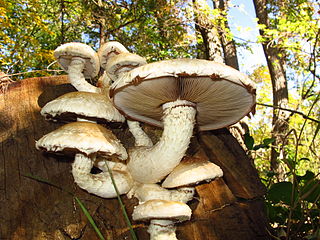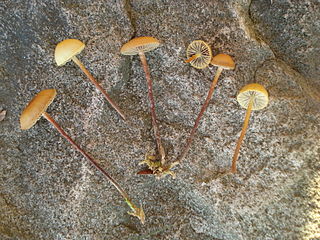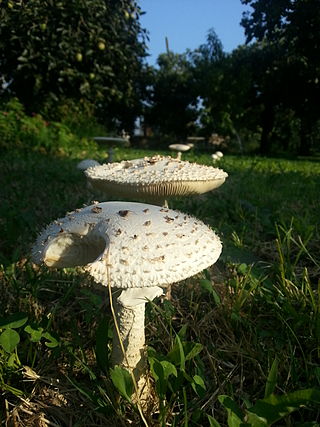Related Research Articles

The Agaricales are an order of fungi in the division Basidiomycota. As originally conceived, the order contained all the agarics, but subsequent research has shown that not all agarics are closely related and some belong in other orders, such as the Russulales and Boletales. Conversely, DNA research has also shown that many non-agarics, including some of the clavarioid fungi and gasteroid fungi belong within the Agaricales. The order has 46 extant families, more than 400 genera, and over 25,000 described species, along with six extinct genera known only from the fossil record. Species in the Agaricales range from the familiar Agaricus bisporus and the deadly Amanita virosa to the coral-like Clavaria zollingeri and bracket-like Fistulina hepatica.

Neolentinus is a genus of wood-decaying agarics with tough fruit bodies composed of dimitic tissue, serrated lamella edges, and nonamyloid white binucleate basidiospores among other features. It was segregated from Lentinus in the broad taxonomic sense, hence the derivation of the name. Biologically Neolentinus species produce a brown rot type of decay of wood, whereas Lentinus causes a white rot. Molecular phylogenetic analysis shows that the two genera are unrelated. Neolentinus is phylogenetically allied to other brown rot genera such as Gloeophyllum, Heliocybe, and Veluticeps. A new order, the Gloeophyllales, has been described for these fungi. Heliocybe had been placed in synonymy but it differs phylogenetically and anatomically by the lack of clamp connections that all Neolentinus produce on their generative hyphae.

The genus Stropharia is a group of medium to large agarics with a distinct membranous ring on the stipe. Well-known members of this genus include the edible Stropharia rugosoannulata and the blue-green verdigris agarics. Stropharia are not generally regarded as good to eat and there are doubts over the edibility of several species. However the species Stropharia rugosoannulata is regarded as prized and delicious when young, and is now the premier mushroom for outdoor bed culture by mycophiles in temperate climates.
Blasiphalia is a fungal genus in the family Repetobasidiaceae. A monotypic genus, it contains the honey colored omphalinoid agaric, Blasiphalia pseudogrisella, which grows with the liverwort genus Blasia. Phylogenetically related agarics are in the genera Rickenella, Gyroflexus, Loreleia, Cantharellopsis and Contumyces, as well as the stipitate-stereoid genera Muscinupta and Cotylidia and clavarioid genus, Alloclavaria. Blasiphalia is most similar to Rickenella and Contumyces, and was only just recognized as a distinct genus in 2007 based upon molecular analysis. The fungus is unique in parasitizing Blasia by forming clasping appresoria on its host's rhizoids. Its basidiospores also germinate on the host's gemmae and clasp them and therefore can be disseminated together with the gemmae.

Heliocybe is an agaric genus closely allied to Neolentinus and the bracket fungus, Gloeophyllum, all of which cause brown rot of wood. Heliocybe sulcata, the type and sole species, is characterized by thumb-sized, tough, revivable, often dried, mushroom fruitbodies, with a tanned symmetric pileus that is radially cracked into a cartoon sun-like pattern of arranged scales and ridges, distant serrated lamellae, and a scaly central stipe. Microscopically it differs from Neolentinus by the absence of clamp connections. Like Neolentinus, it produces abundant, conspicuous pleurocystidia. Heliocybe sulcata typically fruits on decorticated, sun-dried and cracked wood, such as fence posts and rails, vineyard trellises in Europe, branches in slash areas, and semi-arid areas such on sagebrush or on naio branches in rain shadow areas of Hawaii, or in open pine forests.

Lichenomphalia is both a basidiolichen and an agaric genus. Most of the species have inconspicuous lichenized thalli that consist of scattered, small, loose, nearly microscopic green balls or foliose small flakes containing single-celled green algae in the genus Coccomyxa, all interconnected by a loose network of hyphae. The agaric fruit bodies themselves are nonlichenized and resemble other types of omphalinoid mushrooms. These agarics lack clamp connections and do not form hymenial cystidia. The basidiospores are hyaline, smooth, thin-walled, and nonamyloid. Most of the species were originally classified in the genera Omphalina or Gerronema. Historically the species were classified with those other genera in the family, the Tricholomataceae together with the nonlichenized species. Lichenomphalia species can be grouped into brightly colored taxa, with vivid yellow and orange colors, versus the grey brown group, depending upon the microscopic pigmentation deposits. Molecular research comparing DNA sequences now place Lichenomphalia close to the redefined genus Arrhenia, which together with several other genera not traditionally considered to be related, fall within the newly redefined Hygrophoraceae.

Mythicomyces is a fungal genus in the family Mythicomycetaceae. A monotypic genus, it contains the single species Mythicomyces corneipes, first described by Elias Fries in 1861. The fungus produces fruit bodies with shiny yellowish-orange to tawny caps that are 1–3 cm (0.4–1.2 in) in diameter. These are supported by stems measuring 2–5.7 cm (0.8–2.2 in) long and 1–2 mm thick. A rare to uncommon species, it is found in northern temperate regions of North America and Europe, where it typically fruits in groups, in wet areas of coniferous forests. There are several species with which M. corneipes might be confused due to a comparable appearance or similar range and habitat, but microscopic characteristics can be used to reliably distinguish between them.

The Mycenaceae are a family of fungi in the order Agaricales. According to the Dictionary of the Fungi, the family contains 10 genera and 705 species. This is one of several families that were separated from the Tricholomataceae as a result of phylogenetic analyses. Taxa in the Mycenaceae are saprobic, have a cosmopolitan distribution, and are found in almost all ecological zones. The family was circumscribed by Caspar van Overeem in 1926.

Tulosesus impatiens is a species of fungus in the family Psathyrellaceae. First described in 1821, it has been classified variously in the genera Psathyrella, Pseudocoprinus, Coprinarius, and Coprinus, before molecular phylogenetics reaffirmed it as a Coprinellus species in 2001. The fungus is found in North America and Europe, where the mushrooms grow on the ground in deciduous forests. The fruit bodies have buff caps that are up to 4 cm (1.6 in) in diameter, held by slender whitish stems that can be up to 10 cm (3.9 in) tall. Several other Coprinopsis species that resemble C. impatiens may be distinguished by differences in appearance, habit, or spore morphology.

Hemipholiota is a genus of agaric fungi in the order Agaricales. It was originally proposed by Rolf Singer in 1962 as a subgenus of Pholiota to contain species with absent or sparse pleurocystidia and absent chrysocystidia. Henri Romagnesi raised it to generic status in 1980, but this naming was invalid as it did not meet the requirements of the International Code of Nomenclature for algae, fungi, and plants. Marcel Bon published the genus validly in 1986.

Parasola auricoma is a species of agaric fungus in the family Psathyrellaceae. First described scientifically in 1886, the species is found in Europe, Japan, and North America. The mushroom was reported in February 2019 in Colombia, in the city of Bogota by the mycologist Juan Camilo Rodriguez Martinez. The small, umbrella-shaped fruit bodies (mushrooms) of the fungus grow in grass or woodchips and are short-lived, usually collapsing with age in a few hours. The caps are up to 6 cm (2.4 in) wide, initially elliptical before flattening out, and colored reddish-brown to greyish, depending on their age and hydration. They are pleated with radial grooves extending from the center to the edge of the cap. The slender, whitish stems are up to 12 cm (4.7 in) long and a few millimeters thick. Microscopically, P. auricoma is characterized by the presence of setae in its cap cuticle. This characteristic, in addition to the relatively large, ellipsoid spores can be used to distinguish it from other morphologically similar Parasola species.

Aphroditeola is an agaric fungal monotypic genus that produces pink cantharelloid fruit bodies on coniferous forest floors. The lamellae are forked and typically the fruit bodies have a fragrant odor described as candy-like, cinnamon-like or pink bubble gum-like.

Bogbodia is a bog-inhabiting agaric fungal genus that colonizes peat and Sphagnum and produces tan-colored fruit bodies. The only species in the genus is Bogbodia uda. Characteristically it forms chrysocystidia and rather large, finely roughened, violaceous basidiospores each with a poorly defined germ pore. The genus differs from Hypholoma which has smaller, smooth basidiospores and typically have cespitose fruit bodies and decay wood. Phylogenetically, Bogbodia is distinct from Hypholoma, Pholiota, and Leratiomyces.

Mycopan is one of several genera of agaric fungi (mushrooms) that were formerly classified in the genus Hydropus or Mycena. Mycopan is currently monotypic, containing the single species Mycopan scabripes. It produces dusky colored fruit bodies that are mycenoid, but lack amyloid or dextrinoid tissues except for the amyloid basidiospores. Its stipe is notably scruffy from cystidioid end cells and unlike true Hydropus it does not bleed clear fluid. Phylogenetically, Mycopan is distant from the Mycenaceae and the type of that family, Mycena, and it is not with the type of Hydropus, Hydropus fuliginarius. Mycopan grouped closest to Baeospora. Baeospora was shown to be in the Cyphellaceae by Matheny and colleagues. Mycopan scabripes grows from debris in forest floors in North America and Europe.

Phloeomana is a bark-inhabiting agaric fungal genus that produces fuscous-colored to whitish mycenoid to omphalinoid fruit bodies in temperate forests. In addition to the type species Phloeomana speirea, 4 other species, P. alba, P. clavata, P. hiemalis and P. minutula, have been placed in the genus. The genus is characterized by nonamyloid smooth, hyaline (translucent) basidiospores and tissues, poorly to moderately differentiated cheilocystidia, diverticulate pileipellis hyphae and general smooth stipe hyphae with scattered caulocystidia. It is one of several mushroom genera formerly classified most recently in Mycena, Omphalina, Hydropus, or Marasmiellus. Phylogenetically, Phloeomana is distant from the Mycenaceae and is closest to a clade or group that includes other former members of Mycena now in Atheniella and Hemimycena clearly excluded from the Mycenaceae and tentatively classified in the Porotheleaceae.
Phaeogalera is a small genus of slender, fleshy bog and swamp-inhabiting mushrooms with large, brownish spores with a germ pore and a hymenium lacking chrysocystidia. Phaeogalera resemble Galerina in their habitat, macroscopic appearance, and spore print color, however, their microscopic characteristics more closely resemble Psilocybe. The type species, Phaeogalera stagnina, has an Arctic-alpine distribution in the Northern Hemisphere extending into the boreal forests and taiga. It grows along the edges of bogs in peaty soils and sometimes amongst Sphagnum or other mosses. This type species has been classified in Galerina, Tubaria and Psilocybe. Modern molecular evidence supports the recognition of Phaeogalera as an independent genus separate from Galerina. The generic name is built upon the antiquated generic name "Galera", now synonymous with Galerina, and with a reference to the darker colors of the basidiospores of Phaeogalera. When originally proposed by Kühner, he forgot to fully cite the original publication for the type species which explains by the name was later validly published by Pegler & Young in 1975. The genus Meottomyces was segregated from Phaeogalera after briefly being classified together by Romagnesi.
Romagnesiella is an agaric fungal genus that colonizes mineral, calcareous or sandy soils in Europe and North Africa. The small brownish fruitbodies have narrowly attached, broad and distant lamellae and poorly differentiated cheilocystidia and pleurocystidia. Spores are thick-walled, brown, smooth, and lack germ pore. The cap surface (pileipellis) is somewhat cellular with irregular puzzle-like to pyriform hyphae. Clamp connections are present in the hyphae. It is most closely related to Crassisporium, both genera being close to the Strophariaceae or the Cortinariaceae.

The genus Saproamanita contains about 24 species of agarics and is one of six genera in the family Amanitaceae. The others are Amanita, Catatrama, Limacellopsis, Zhuliangomyces and Limacella. Saproamanita are the saprophytic species in the Tribe Amaniteae, separately classified from the ectomycorrhizal species in the genus Amanita.
References
- ↑ Redhead SA, Smith AH (1986). "Two new genera of agarics based on Psilocybe corneipes and Phaeocollybia perplexa". Canadian Journal of Botany. 64 (3): 643–47. doi:10.1139/b86-082.
- ↑ Gulden GØ, Stensrud K, Shalchian-Tabrizi K, Kauserud H (2005). "Galerina Earle: A polyphyletic genus in the consortium of dark-spored agarics" (PDF). Mycologia. 97 (4): 823–837. doi:10.3852/mycologia.97.4.823. PMID 16457352.
- ↑ Moncalvo JM, Vilgalys R, Redhead SA, Johnson JE, James TY, Catherine Aime M, Hofstetter V, Verduin SJ, Larsson E, Baroni TJ, Greg Thorn R, Jacobsson S, Clémençon H, Miller OK (2002). "One hundred and seventeen clades of euagarics" (PDF). Molecular Phylogenetics and Evolution. 23 (3): 357–400. doi:10.1016/S1055-7903(02)00027-1. PMID 12099793.
- ↑ Padamsee M, Matheny PB, Dentinger BTM, McLaughlin DJ (2008). "The mushroom family Psathyrellaceae: Evidence for large-scale polyphyly of the genus Psathyrella". Molecular Phylogenetics and Evolution. 46 (2): 415–429. doi:10.1016/j.ympev.2007.11.004. PMID 18248744.
- ↑ Vizzini A, Consiglio G, Marchett M (2019). "Mythicomycetaceae fam. nov. (Agaricineae, Agaricales) for accommodating the genera Mythicomyces and Stagnicola, and Simocybe parvispora reconsidered". Fungal Systematics and Evolution. 3: 41–56. doi:10.3114/fuse.2019.03.05. PMC 7235982 . PMID 32467883.
- ↑ Castellano MA, Cázares E, Fondrick B, Dreisbachulden T (2003). "Handbook to Additional Fungal Species of Special Concern in the Northwest Forest Plan" (PDF). United States Department of Agriculture Forest Service, Pacific Northwest Research Station General Technical Report PNW-GTR-572.